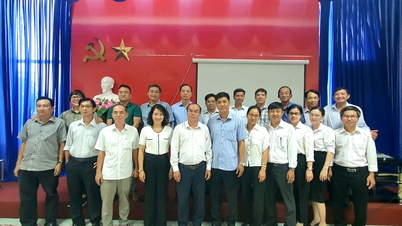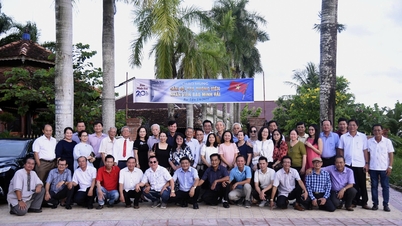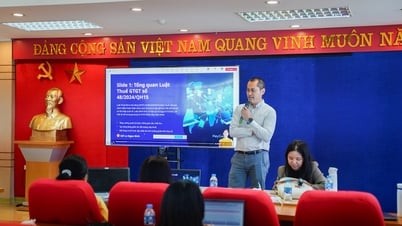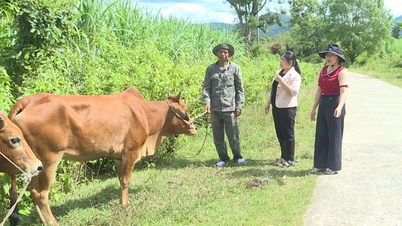 Over the years, the province has always paid attention to, invested in, and upgraded the rural power grid system in the area, basically meeting the production and living needs of the people. However, due to the process of socio-economic development, the capacity and output of electricity consumption have increased rapidly, causing the rural power grid to have problems, shortcomings, and risks of being unsafe, so it is in great need of investment to upgrade and modernize.
Over the years, the province has always paid attention to, invested in, and upgraded the rural power grid system in the area, basically meeting the production and living needs of the people. However, due to the process of socio-economic development, the capacity and output of electricity consumption have increased rapidly, causing the rural power grid to have problems, shortcomings, and risks of being unsafe, so it is in great need of investment to upgrade and modernize.

Staff of Hop Thinh Electricity Service Cooperative, Tam Duong district, check the safety of the power grid in the area.
According to statistics from the Department of Industry and Trade, the rural low-voltage grid infrastructure system in the province currently has over 3,400 km of lines. Of which, Vinh Phuc Electricity Company manages and operates over 1,900 km of electricity; units outside the Electricity sector manage and operate nearly 1,500 km.
The total number of transformer stations is nearly 1,600 with a total capacity of nearly 550 thousand kVA, supplying electricity to nearly 320 thousand customers. Of which, Vinh Phuc Electricity Company manages and operates 837 transformer stations with a capacity of nearly 260 thousand kVA, selling electricity to more than 146 thousand customers in rural areas, the rest are managed and operated by units outside the Electricity sector.
The total number of rural electricity retail units in the province is 72 units, including 8 district and city power companies under Vinh Phuc Electricity Company; 8 electricity selling units not using REII loans and 56 electricity selling units using REII loans (Rural Energy Project II with World Bank loans).
Up to now, 100% of households in the province have access to the national power grid, the number and severity of electrical safety incidents have been reduced, the stability and quality of electricity have been improved, contributing to improving people's lives, promoting socio-economic development, and ensuring national defense and security in the locality.
Despite many important achievements, investment in upgrading the power grid in recent times has not kept up with the growth rate of load and socio-economic development in rural areas. Currently, the growth of electricity output in this area has reached an average of nearly 13% per year.
In some rural areas, the low-voltage grid has degraded after many years of operation, but has not received investment attention for renovation and repair, leading to problems and shortcomings such as the risk of electrical safety in both medium and low voltage grids; grid overload; poor quality power supply; waste in electricity use, etc.
Coordination between levels and sectors in energy development management is not tight, with many shortcomings; many issues are slow to be resolved for units. Electricity loss has decreased, but is still high, averaging 9-12%/year.
The representative of the Department of Industry and Trade said: "Focus on solutions to improve quality and modernize rural power grids to meet people's needs and the process of socio-economic development, industrialization and modernization of rural areas."
Based on the direction of the province and review and assessment of the actual situation in localities, in the coming time, the Department of Industry and Trade will focus on coordinating with localities and related units to synchronously deploy solutions to comprehensively improve the quality of rural power grid infrastructure in the whole province.
In particular, directing rural electricity retailers to review and correctly assess the current status of the power grid infrastructure under their management, promptly renovate, repair and upgrade the power grid, and be ready to quickly handle incidents to ensure safe and stable operation of the power grid to serve the needs of socio-economic development and daily life of local people.
Strengthen propaganda to encourage customers to use electricity economically, safely and effectively; limit the use of high-power consuming devices during peak hours of the power system.
Focus on investing in building more transformer stations to share the load, reduce the power supply radius to improve the quality of the voltage at the source, reduce power loss and prevent overloading of fully loaded transformers.
Accelerate digital transformation in the energy sector, aiming to maximize and automate networks for efficient electricity supply. Connect digital electricity meters to improve the speed and accuracy of electricity measurement, quickly identify problems, support users in saving energy and detect electricity losses.
Support and facilitate cooperative units operating in the electricity sales business that need to convert into joint stock companies or limited liability companies in accordance with the provisions of law and ensure the payment of the remaining REII project loan capital...
By 2025, 100% of units will meet the electricity criteria in the construction of advanced and model new rural areas and model cultural villages, with the electricity loss rate reduced to below 8%/year.
Article and photos: Nguyen Khanh
Source

































































































Comment (0)